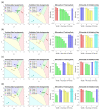A Real-Time Application for the Analysis of Multi-Purpose Vending Machines with Machine Learning
- PMID: 36850535
- PMCID: PMC9967936
- DOI: 10.3390/s23041935
A Real-Time Application for the Analysis of Multi-Purpose Vending Machines with Machine Learning
Abstract
With the development of mobile payment, the Internet of Things (IoT) and artificial intelligence (AI), smart vending machines, as a kind of unmanned retail, are moving towards a new future. However, the scarcity of data in vending machine scenarios is not conducive to the development of its unmanned services. This paper focuses on using machine learning on small data to detect the placement of the spiral rack indicated by the end of the spiral rack, which is the most crucial factor in causing a product potentially to get stuck in vending machines during the dispensation. To this end, we propose a k-means clustering-based method for splitting small data that is unevenly distributed both in number and in features due to real-world constraints and design a remarkably lightweight convolutional neural network (CNN) as a classifier model for the benefit of real-time application. Our proposal of data splitting along with the CNN is visually interpreted to be effective in that the trained model is robust enough to be unaffected by changes in products and reaches an accuracy of 100%. We also design a single-board computer-based handheld device and implement the trained model to demonstrate the feasibility of a real-time application.
Keywords: convolutional neural network; k-means; real-time application; small data; smart vending machines; visual interpretation.
Conflict of interest statement
The authors declare no conflict of interest.
Figures









References
-
- Gruber S., Buber R., Ruso B., Gadner J. The commodity vending machine. InForum Ware Int. 2005;2:32–42.
-
- Higuchi Y. History of the development of beverage vending machine technology in Japan. Natl. Mus. Nat. Sci. Surv. Rep. Syst. Technol. 2007;7:1–69.
-
- Yokouchi T. Today and tomorrow of vending machine and its services in Japan; Proceedings of the 2010 7th International Conference on Service Systems and Service Management; Tokyo, Japan. 28–30 June 2010; - DOI
-
- DeYoung R., Lang W.W., Nolle D.L. How the Internet affects output and performance at community banks. J. Bank. Financ. 2007;31:1033–1060. doi: 10.1016/j.jbankfin.2006.10.003. - DOI
-
- Goode M., Moutinho L. The effects of free banking on overall satisfaction: The use of automated teller machines. Int. J. Bank Mark. 1995;13:33–40. doi: 10.1108/02652329510082942. - DOI
LinkOut - more resources
Full Text Sources

